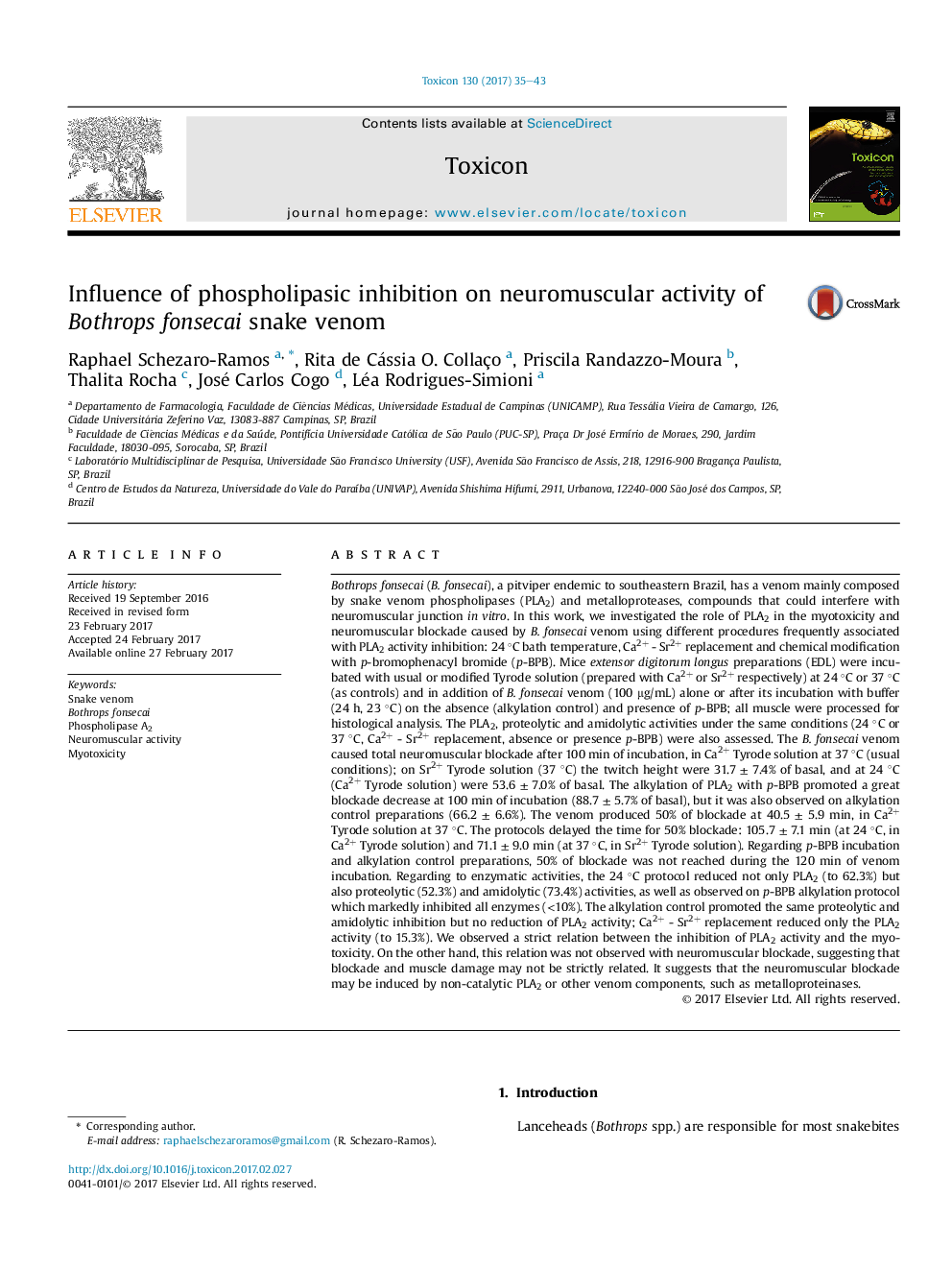| Article ID | Journal | Published Year | Pages | File Type |
|---|---|---|---|---|
| 5519309 | Toxicon | 2017 | 9 Pages |
â¢Efficiency of classical PLA2 activity inhibition procedures are compared.â¢Neuromuscular blockade was related to non-enzymatic PLA2 or other venom proteins.â¢Enzymatic activity of PLA2 seems to be the major responsible of myotoxicity.â¢No strict relation between myotoxicity and neuromuscular blockade.
Bothrops fonsecai (B. fonsecai), a pitviper endemic to southeastern Brazil, has a venom mainly composed by snake venom phospholipases (PLA2) and metalloproteases, compounds that could interfere with neuromuscular junction in vitro. In this work, we investigated the role of PLA2 in the myotoxicity and neuromuscular blockade caused by B. fonsecai venom using different procedures frequently associated with PLA2 activity inhibition: 24 °C bath temperature, Ca2+ - Sr2+ replacement and chemical modification with p-bromophenacyl bromide (p-BPB). Mice extensor digitorum longus preparations (EDL) were incubated with usual or modified Tyrode solution (prepared with Ca2+ or Sr2+ respectively) at 24 °C or 37 °C (as controls) and in addition of B. fonsecai venom (100 μg/mL) alone or after its incubation with buffer (24 h, 23 °C) on the absence (alkylation control) and presence of p-BPB; all muscle were processed for histological analysis. The PLA2, proteolytic and amidolytic activities under the same conditions (24 °C or 37 °C, Ca2+ - Sr2+ replacement, absence or presence p-BPB) were also assessed. The B. fonsecai venom caused total neuromuscular blockade after 100 min of incubation, in Ca2+ Tyrode solution at 37 °C (usual conditions); on Sr2+ Tyrode solution (37 °C) the twitch height were 31.7 ± 7.4% of basal, and at 24 °C (Ca2+ Tyrode solution) were 53.6 ± 7.0% of basal. The alkylation of PLA2 with p-BPB promoted a great blockade decrease at 100 min of incubation (88.7 ± 5.7% of basal), but it was also observed on alkylation control preparations (66.2 ± 6.6%). The venom produced 50% of blockade at 40.5 ± 5.9 min, in Ca2+ Tyrode solution at 37 °C. The protocols delayed the time for 50% blockade: 105.7 ± 7.1 min (at 24 °C, in Ca2+ Tyrode solution) and 71.1 ± 9.0 min (at 37 °C, in Sr2+ Tyrode solution). Regarding p-BPB incubation and alkylation control preparations, 50% of blockade was not reached during the 120 min of venom incubation. Regarding to enzymatic activities, the 24 °C protocol reduced not only PLA2 (to 62.3%) but also proteolytic (52.3%) and amidolytic (73.4%) activities, as well as observed on p-BPB alkylation protocol which markedly inhibited all enzymes (<10%). The alkylation control promoted the same proteolytic and amidolytic inhibition but no reduction of PLA2 activity; Ca2+ - Sr2+ replacement reduced only the PLA2 activity (to 15.3%). We observed a strict relation between the inhibition of PLA2 activity and the myotoxicity. On the other hand, this relation was not observed with neuromuscular blockade, suggesting that blockade and muscle damage may not be strictly related. It suggests that the neuromuscular blockade may be induced by non-catalytic PLA2 or other venom components, such as metalloproteinases.
